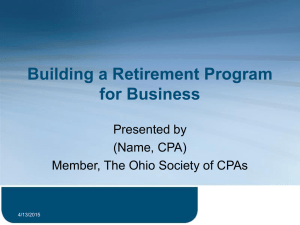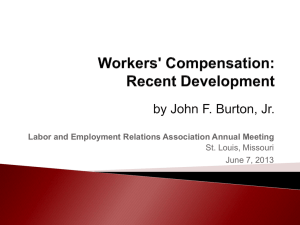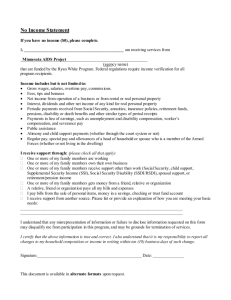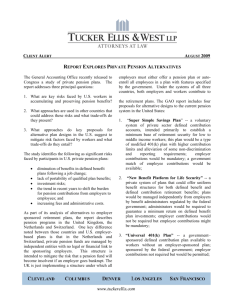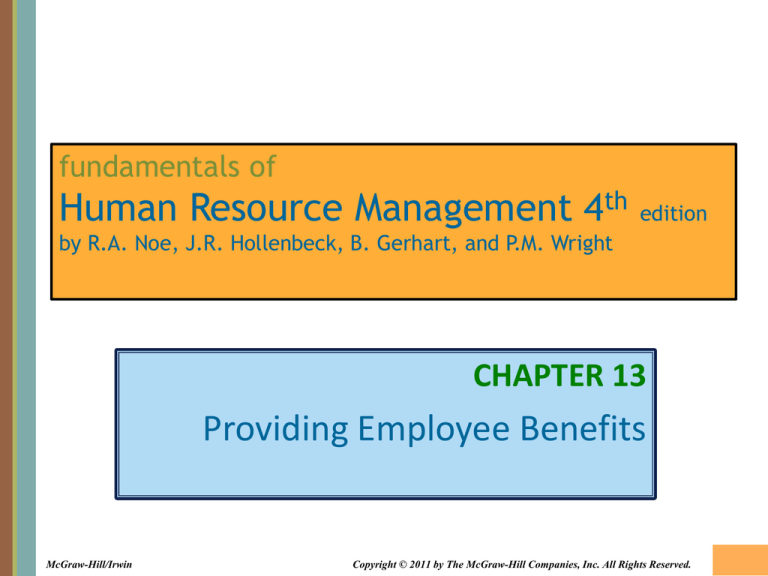
fundamentals of
Human Resource Management 4th
edition
by R.A. Noe, J.R. Hollenbeck, B. Gerhart, and P.M. Wright
CHAPTER 13
Providing Employee Benefits
McGraw-Hill/Irwin
Copyright © 2011 by The McGraw-Hill Companies, Inc. All Rights Reserved.
13-1
What Do I Need to Know?
1. Discuss the importance of benefits as a part
of employee compensation.
2. Summarize the types of employee benefits
required by law.
3. Describe the most common forms of paid
leave.
4. Identify the kinds of insurance benefits
offered by employers.
13-2
What Do I Need to Know? (continued)
5. Define the types of retirement plans offered
by employers.
6. Describe how organizations use other
benefits to match employees’ wants and
needs.
7. Explain how to choose the contents of an
employee benefits package.
13-3
What Do I Need to Know? (continued)
8. Summarize the regulations affecting how
employers design and administer benefits
programs.
9. Discuss the importance of effectively
communicating the nature and value of
benefits to employees.
13-4
Figure 13.1: Benefits as a Percentage of
Total Compensation
13-5
The Role of Employee Benefits
• Benefits contribute to attracting, retaining,
and motivating employees.
• The variety of possible benefits helps
employers tailor their compensation to the
kinds of employees they need.
• Employees have come to expect that benefits
will help them maintain economic security.
• Benefits impose significant costs.
13-6
The Role of Employee Benefits (continued)
• Benefits packages are more complex than pay
structures, making them harder for employees
to understand and appreciate.
• The important role of benefits is one reason
that benefits are subject to government
regulation.
– Legally required benefits.
– Tax laws can make benefits favorable.
13-7
Table 13.1: Benefits Required by Law
13-8
Benefits Required by Law:
Social Security
• The federal Old Age, Survivors, Disability, and
Health Insurance (OASDHI) program which
combines:
– Old age (retirement) insurance
– Survivor’s insurance
– Disability insurance
– Hospital insurance (Medicare Part A)
– Supplementary medical insurance
(Medicare Part B)
13-9
Benefits Required by Law:
Social Security (continued)
• Employers and employees share the cost of
Social Security through a payroll tax. The
percentage is set by law.
• In 2009, employers and employees each paid a
tax of 7.65% on the first $106,800 of the
employee’s earnings
– 6.2% of earnings goes to OASDHI
– 1.45% of earnings goes to Medicare (Part A)
– For earnings above $106,800 only the 1.45% for
Medicare is assessed
13-10
Benefits Required by Law:
Unemployment Insurance
• A federally mandated program administered
by the states.
• Focuses on minimizing the hardships of
unemployment:
– Payments to unemployed workers.
– Help in finding new jobs.
– Incentives to stabilize employment.
• Most funding comes from federal and state
taxes on employers.
13-11
Benefits Required by Law:
Unemployment Insurance (continued)
• The size of the unemployment tax imposed on
each employer depends on the employer’s
experience rating:
– The number of employees a company has laid off
in the past and the cost of providing them with
unemployment benefits.
• Careful human resource planning can
minimize layoffs and keep their experience
rating favorable.
13-12
Benefits Required by Law:
Unemployment Insurance (continued)
To receive benefits, workers must meet four
conditions:
1.They meet requirements demonstrating they
had been employed.
2.They are available for work.
3.They are actively seeking work.
4.They were not discharged for cause, did not
quit voluntarily, and are not out of work
because of a labor dispute.
13-13
Benefits Required by Law:
Workers’ Compensation
• State programs that provide benefits to
workers who suffer work-related injuries or
illnesses, or to their survivors.
• They operate under a principle of no-fault
liability:
– An employee does not need to show that the
employer was grossly negligent in order to receive
compensation.
– The employer is protected from lawsuits.
13-14
Benefits Required by Law:
Workers’ Compensation (continued)
• Major categories of benefits:
– Disability income
– Medical care
– Death benefits
– Rehabilitative benefits
• The amount of benefits income varies from
state to state. It is generally two-thirds of the
worker’s earnings before the disability.
• The benefits are tax free.
13-15
Benefits Required by Law:
Workers’ Compensation (continued)
• The cost of the workers’ compensation
insurance depend on the:
– Kinds of occupations involved
– State where the company is located
– Employer’s experience rating
• Unfavorable experience ratings lead to higher
insurance premiums.
13-16
Benefits Required by Law:
Unpaid Family and Medical Leave
• Family and Medical Leave Act (FMLA) of 1993
– Requires organizations with 50 or more
employees to provide up to 12 weeks of unpaid
leave:
• After childbirth or adoption
• To care for a seriously ill family member
• For an employee’s own serious illness
– Employers must also guarantee these employees
the same or comparable job when they return to
work.
13-17
Benefits Required by Law:
Unpaid Family and Medical Leave (continued)
• When employees experience pregnancy and
childbirth, employers must also comply with
the Pregnancy Discrimination Act.
• If an employee is temporarily unable to
perform her job due to pregnancy, the
employer must treat her in the same way as
any other disabled employee.
– e.g., modified tasks, alternative assignments,
disability leave, or leave without pay
13-18
Test Your Knowledge
• XYZ company has determined that they will have to
reduce their benefits costs to stay competitive.
Which of the following solutions is not a choice for
XYZ?
a) Eliminate health coverage
b) Reduce the percentage of employees’ Social Security
insurance they pay.
c) Reduce their unemployment insurance costs by
managing their workforce to avoid layoffs.
d) Institute a safety program to minimize worker’s
compensation costs.
13-19
Optional Benefits Programs
Paid Leave
Group
Insurance
“FamilyFriendly”
Benefits
Retirement
Plans
Other Quality
of Work-Life
Benefits
13-20
Figure 13.2: Percentage of Full-Time Workers with
Access to Selected Benefit Programs
13-21
Optional Benefits Programs:
Paid Time Off
•
•
•
•
•
•
•
•
•
Vacation
Holidays
Sick Leave
Personal Days
Floating Holidays
Jury Duty
Funerals
Military Duty
Time Off to Vote
• Paid Time Off (PTO)
Bank
– Most flexible approach
– Employer pools pools
personal days, sick days,
and vacation days for
employees to use as the
need arises
13-22
Paid time off is a way for employees
to enjoy time with their families and
to refresh their bodies and spirits.
13-23
U.S. and Japanese Workers Take
Short Vacations
• On average, workers in
the United States take
11 of their 13 vacation
days.
• Japanese workers , on
average, receive 15
vacation days but only
take 7.
13-24
Optional Benefits Programs:
Group Insurance
Medical Insurance
Life Insurance
Disability Insurance
Long-Term Care Insurance
13-25
Medical Insurance
• 70% of all full-time
• Additional coverage
employees in the U.S.
may include:
receive medical benefits
– Dental care
– Vision care
• Policies typically cover:
– Hospital expenses
– Surgical expenses
– Visits to physicians
– Birthing centers
– Prescription drug
programs
• Mental Health Parity
Act (1996)
13-26
Medical Insurance (continued)
• Consolidated Omnibus Budget Reconciliation
Act (COBRA) of 1985
– Federal law that requires employers to permit
employees or their dependents to extend their
health insurance coverage at group rates for up to
36 months following a qualifying event:
• Layoff
• Reduction in hours
• Employee’s death
13-27
Medical Insurance (continued)
Employer approaches to controlling health
care benefits costs:
1.Managed Care
2.Health Maintenance Organizations (HMO)
3.Preferred Provider Organizations (PPO)
4.Flexible Spending Accounts
5.Consumer-Driven Health Plans (CDHP)
6.Employee Wellness Programs (EWP)
13-28
Figure 13.3:
Health Care Costs in Various Countries
13-29
Life Insurance
• Employers may provide life insurance to
employees or offer the opportunity to buy
coverage at low group rates.
• Term life insurance – if the employee dies
during the term of the policy, the employee’s
beneficiaries receive a death benefit payment.
– Usually twice the employee’s yearly pay.
• Additional benefits may include accidental
death and dismemberment.
13-30
Disability Insurance
Short-Term Disability Insurance
• Insurance that pays a
percentage of a disabled
employee’s salary as
benefits to the employee
for six months or less.
Long-Term Disability Insurance
• Insurance that pays a
percentage of a disabled
employee’s salary after an
initial period and
potentially for the rest of
the employee’s life.
13-31
Optional Benefits Programs:
Retirement Plans
• About half of employees working in the
private business sector have employersponsored retirement plans.
• Contributory plan - retirement plan funded by
contributions from the employer and
employee.
• Noncontributory plan - retirement plan
funded entirely by contributions from the
employer.
13-32
Figure 13.4: Sources of Income for Persons
65 and Older
13-33
Optional Benefits Programs:
Retirement Plans (continued)
• Defined benefit plan – pension plan that guarantees
a specified level of retirement income.
• The employer sets up a pension fund to invest the
contributions.
• Such plans must meet the funding requirements of
the Employee Retirement Income Security Act
(ERISA) of 1974.
– The employer must contribute enough for the plan to
cover all the benefits to be paid out to retirees.
13-34
Optional Benefits Programs:
Retirement Plans (continued)
• Employee Retirement
Income Security Act
(ERISA): federal law that
increased the responsibility
of pension plan trustees to
protect retirees, established
certain rights related to
vesting and portability, and
created the Pension Benefit
Guarantee Corporation.
• Pension Benefit Guarantee
Corporation (PBGC):
federal agency that insures
retirement benefits and
guarantees retirees a basic
benefit if the employer
experiences financial
difficulties.
13-35
Optional Benefits Programs:
Retirement Plans (continued)
• Defined contribution plan – retirement plan in which
the employer sets up an individual account for each
employee and specifies the size of the investment
into that account.
– Money purchase plans
– Profit-sharing and employee stock ownership plans
– Section 401(k) plans
• These plans free employers from the risks that
investments will not perform as well as expected.
• The responsibility for wise investing is with each
employee.
13-36
Figure 13.5: Value of Retirement Savings
Invested at Different Ages
13-37
Test Your Knowledge
• Jakar does not know a lot about investing and wants
to ensure he has some retirement income when he is
old enough to retire. Agnes plans on changing
employers every few years and is interested in
investing her own money. Which plan would be best
for Jakar and Agnes, respectively?
a)
b)
c)
d)
Defined contribution; defined benefit
Contributory; defined benefit
Defined benefit; defined contribution
Defined contribution; non-contributory
13-38
Optional Benefits Programs:
Retirement Plans (continued)
• Cash balance plan – retirement plan in which the
employer sets up an individual account for each
employee and contributes a percentage of the
employee’s salary.
– The account earns interest at a predefined rate.
– This arrangement helps employers plan their contributions
and helps employees predict their retirement benefits.
– If employees change jobs, they generally can roll over the
balance into an individual retirement account (IRA).
13-39
Optional Benefits Programs:
Retirement Plans (continued)
Vesting Rights
• Guarantee that when
employees become
participants in a pension
plan and work a specified
number of years, they will
receive a pension at
retirement age, regardless
of whether they remained
with the employer.
Summary Plan Description
• Report that describes a
pension plan’s funding,
eligibility requirements,
risks, and other details.
• Employers also provide an
individual benefit
statement which describes
the employee’s vested and
unvested benefits.
13-40
Optional Benefits Programs:
“Family-Friendly” Benefits
Family Leave
Child Care Benefits
College Savings Plans
Elder Care
13-41
Figure 13.6: Percentage of Employees with
Various Levels of Child Care Benefits
13-42
Optional Benefits Programs:
Other Quality of Work-Life Benefits
• Subsidized cafeterias
• On-site health care
services
• Moving and relocation
expenses
• Employee discounts on
products
• Employee buying
service
• Tuition reimbursement
• On-site fitness center
• On-site dry cleaning
services
• Dues for professional
organizations
• Off-site company
recreation area
• Pet services
13-43
Selecting Employee Benefits
• Decisions about which benefits to offer should
take into account:
– The organization’s goals and objectives
– The organization’s budget
– The expectations of the organization’s current
employees and those it wishes to recruit in the future.
• An organization that does not offer expected
benefits will have difficulty attracting and keeping
employees.
13-44
Table 13.2:
An Organization’s Benefits Objectives
13-45
Employees’ Expectations and Values
• Employees expect to receive benefits that are
legally required and widely available.
• They value benefits they are likely to use.
• The value employees place on various benefits
is likely to differ from one employee to
another.
13-46
Employee Expectations and Values
(continued)
• Organizations can
address differences in
employees’ needs and
empower their
employees by offering
flexible benefits plans in
place of a single
benefits package for all
employees.
• Cafeteria-style plan: a
benefits plan that offers
employees a set of
alternatives from which
they can choose the
types and amounts of
benefits they want.
13-47
Suggested Ways Employers Can Control the
Cost of Health Benefits
1. Shop for bargains. Every year, the company should
research available plans and compare quotes from
different providers.
2. Know what employees care about. Would they be
willing to accept a higher deductible if it means the
company can also afford prescription drug
coverage?
3. If employees are willing to take responsibility for
their own health care spending, offer a healthsavings account or consumer-driven plan.
13-48
Suggested Ways Employers Can Control the
Cost of Health Benefits (continued)
4. Review your claims history. You might be able to
identify correctable problems.
5. Encourage healthy behavior with incentives like
discounts for health club memberships, free health
screenings, and lower premiums for employees who
participate in a wellness program.
6. Promote a workplace culture that values healthy
habits.
7. Measure the results of any initiative you try.
13-49
Legal Requirements for Employee Benefits
Benefits required by law
Tax treatment of benefits
Antidiscrimination laws
Accounting requirements
13-50
Communicating Benefits to Employees
• Organizations must communicate benefits
information to employees so that they will
appreciate the value of their benefits.
• This is essential so that benefits can achieve
their objective of attracting, motivating, and
retaining employees.
• Employees are interested in their benefits,
and they need a great deal of detailed
information to take advantage of benefits.
13-51
Summary
• Like pay, benefits help employers attract, retain, and
motivate employees. The variety of possible benefits
also helps employers tailor their compensation
packages to attract the right kinds of employees.
• Employees expect at least a minimum level of
benefits, and providing more than the minimum
helps an organization compete in the labor market.
• Benefits are also a significant expense, but employers
provide benefits because employees value them and
many benefits are required by law.
13-52
Summary (continued)
• Employers must contribute to the Old Age, Survivors,
Disability, and Health Insurance program known as
Social Security through a payroll tax shared by
employers and employees.
• Employers must also pay federal and state taxes for
unemployment insurance.
• State laws require that employers purchase workers’
compensation insurance.
• The major categories of paid leave are vacations,
holidays, and sick leave.
13-53
Summary (continued)
• Medical insurance is one of the most valued
employee benefits.
• To manage the costs of health insurance, many
organizations offer coverage through a health
maintenance organization or preferred provider
organization, or they may offer flexible spending
accounts.
• Retirement plans may be contributory or
noncontributory. These plans may be defined benefit
plans or defined contribution plans.
13-54
Summary (continued)
• Employers have responded to work-family role
conflicts by offering family-friendly benefits.
• In deciding the contents of a benefits package,
organizations need to establish objectives and select
benefits that support those objectives.
• Organizations should also consider employees’
expectations and values.
• Employers must comply with the numerous laws and
regulations affecting how they design and administer
benefits programs.
13-55
Summary (continued)
• Communicating information about benefits is
important so that employees will appreciate the
value of their benefits.
• Communicating their value is the main way benefits
attract, motivate, and retain employees.
13-56





